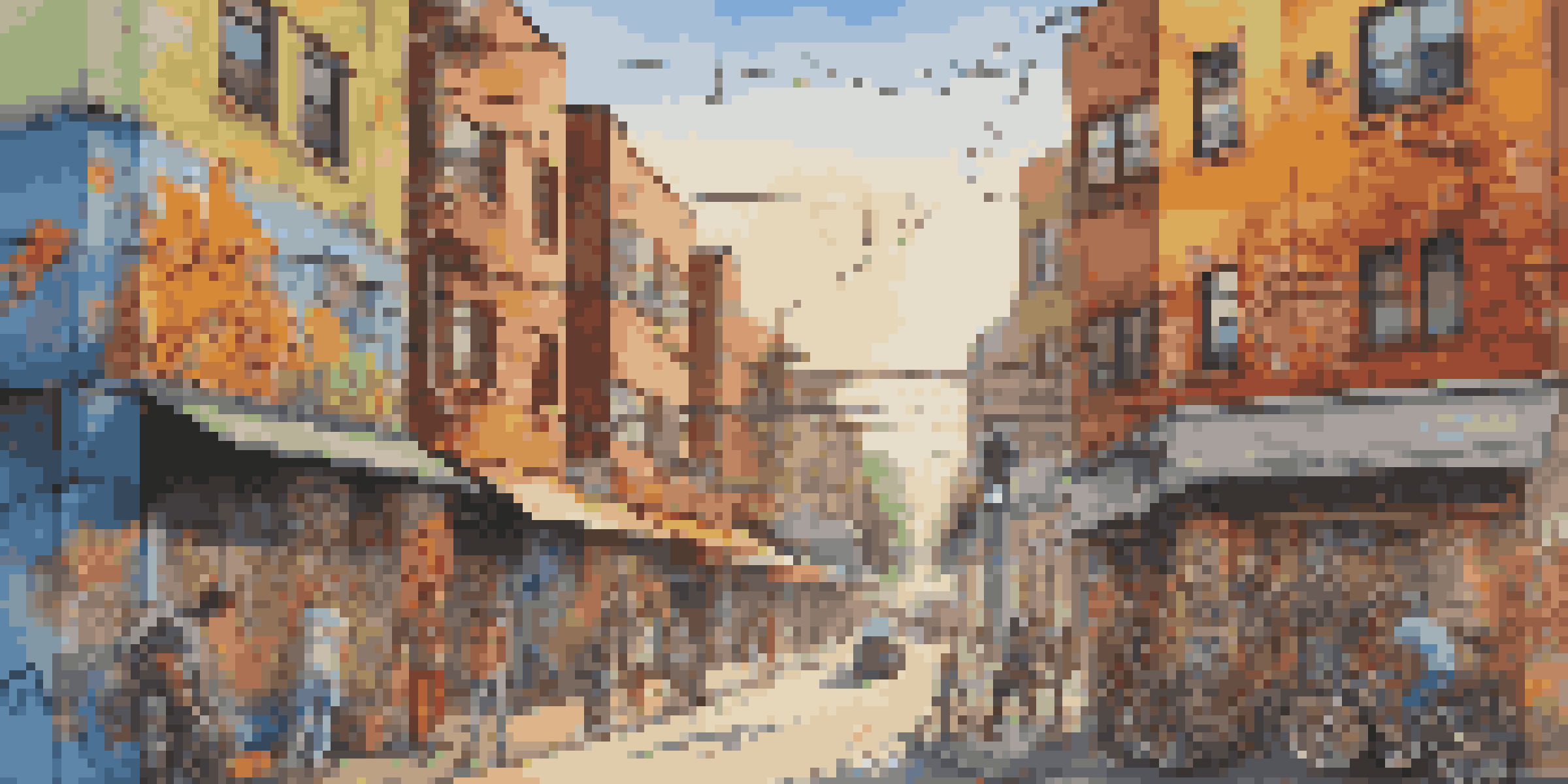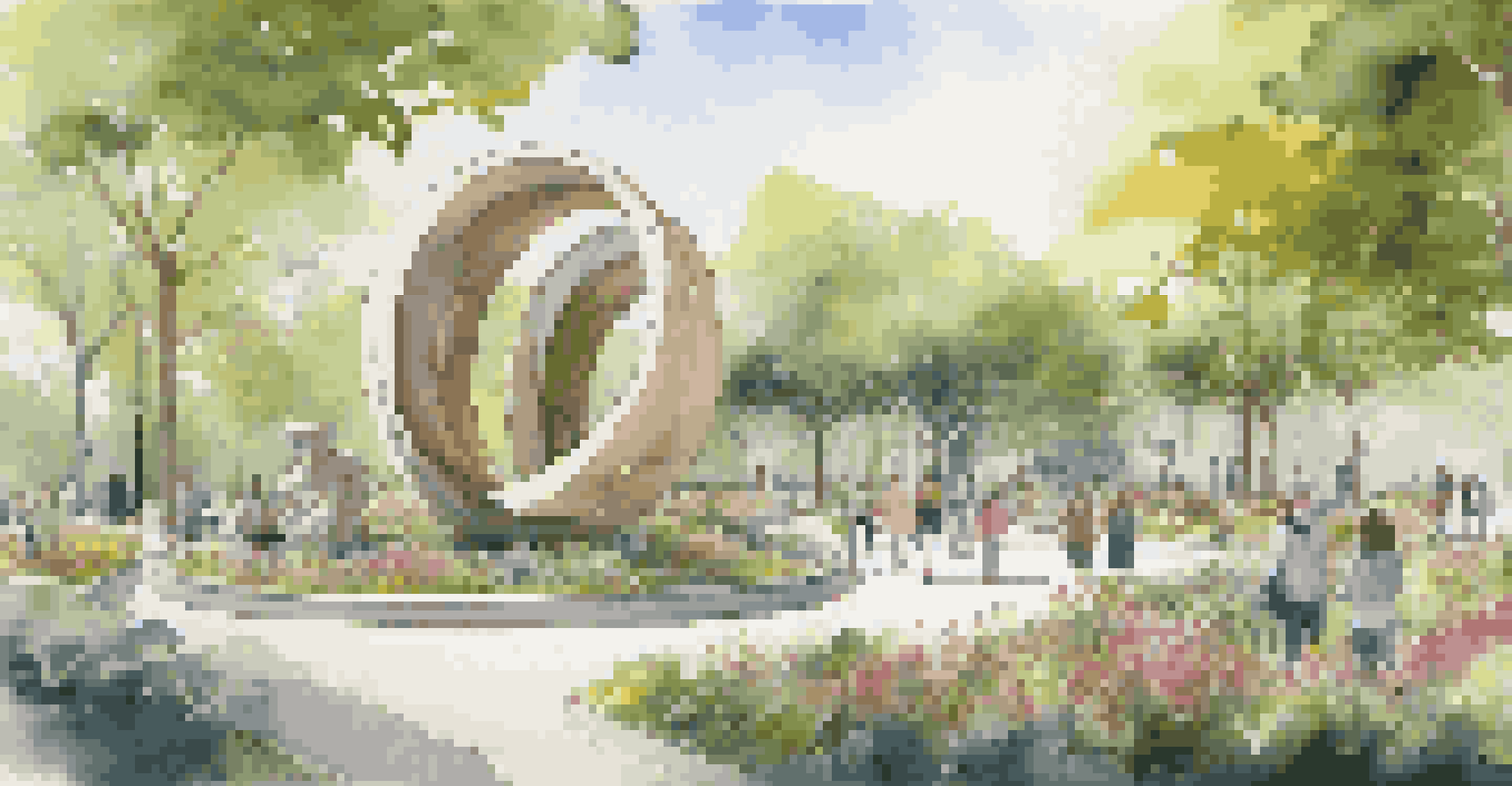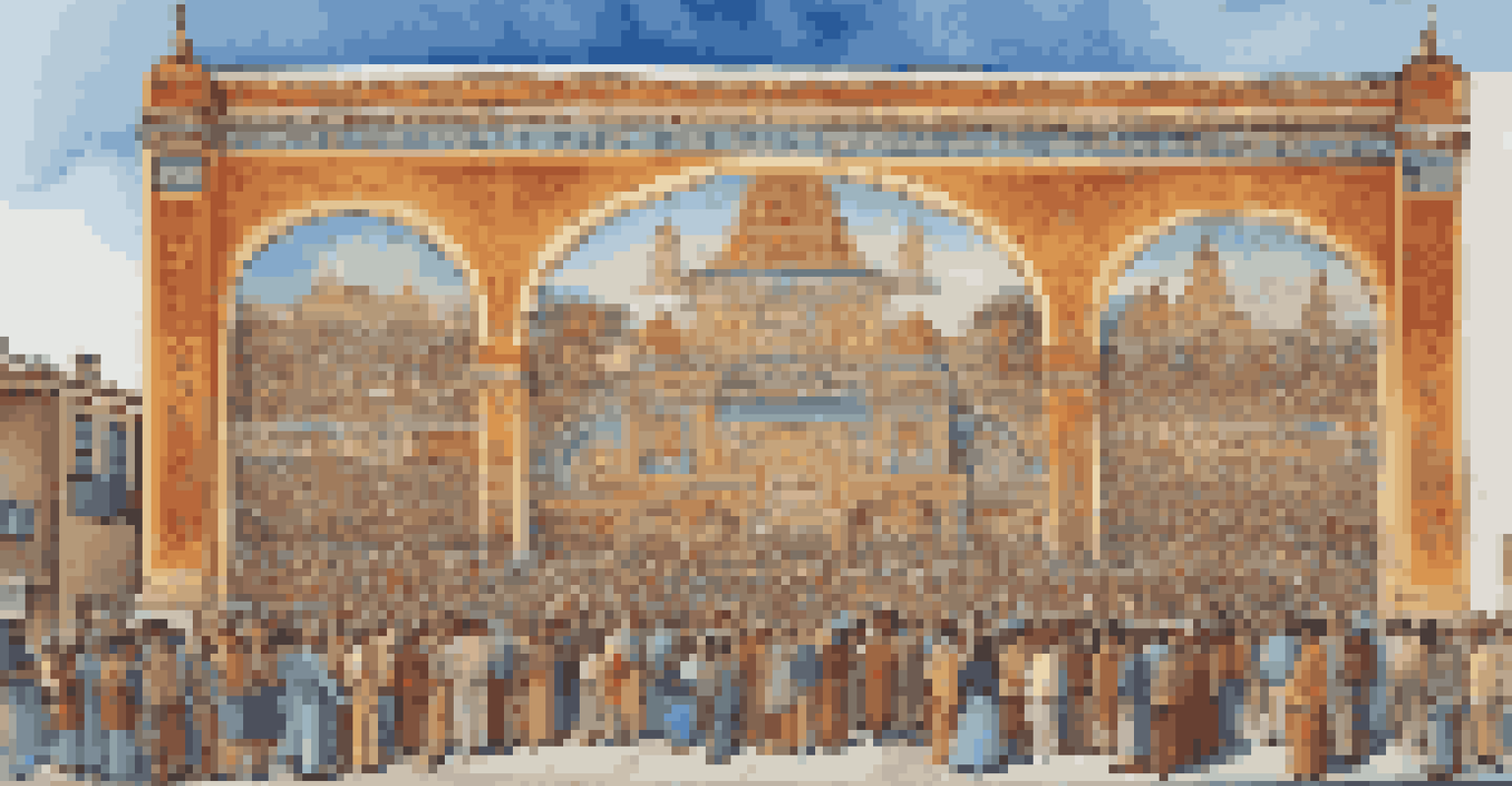The History of Public Art Movements: A Timeline of Change

Early Beginnings: Public Art in Ancient Civilizations
Public art has roots that stretch back to ancient civilizations, where monuments, sculptures, and murals were created to reflect cultural values and beliefs. In places like Egypt and Greece, grand structures were not just for decoration; they served as symbols of power and religion. For instance, the Pyramids of Giza were not only architectural marvels but also representations of the afterlife and divine order.
Art is not what you see, but what you make others see.
As time progressed, the Greeks and Romans further developed public art, creating statues and reliefs that celebrated their gods and heroes in public spaces. These artworks were integral to civic pride and community identity, often serving as gathering points for social and political discourse. The sheer scale and craftsmanship of these works left a lasting legacy on how art could engage the public.
This early period set the stage for the evolution of public art, highlighting its role not just as decoration but as a means of communication and connection within society. Public art began to be seen as a reflection of the values and aspirations of the people, making it a crucial element in the narrative of human civilization.
The Renaissance: A Flourishing of Public Art
The Renaissance marked a pivotal moment for public art, with artists like Michelangelo and Raphael elevating the genre to new heights. This period saw a resurgence of interest in classical themes, humanism, and the natural world, which were often depicted in murals and sculptures throughout cities. In Florence, the dome of the Cathedral of Santa Maria del Fiore became a symbol of artistic achievement and civic pride.

Public spaces were transformed into galleries, with art that inspired awe and contemplation. The Sistine Chapel's ceiling, painted by Michelangelo, is a prime example of how public art could convey complex theological narratives while captivating viewers. This period highlighted the potential of art to not only beautify but also educate and inspire the public.
As the Renaissance flourished, so did the idea of the artist as a public figure, blurring the lines between artist and community. Art became a communal experience, inviting people to engage with their heritage and shared values, thus reinforcing the bond between art, society, and the individual.
The 18th and 19th Centuries: Art as Social Commentary
The 18th and 19th centuries ushered in a new era where public art began to serve as a powerful tool for social commentary. The Enlightenment brought forward ideas of liberty, equality, and fraternity, which artists sought to express through their work. Public monuments, such as the Statue of Liberty, emerged as symbols of hope and progress, reflecting societal changes.
Public art should be a reflection of the community it serves.
During this time, artists like Eugène Delacroix used their art to comment on political revolutions and social issues, making public spaces a stage for discourse. The rise of Romanticism further emphasized personal expression, with artists using public art to provoke thought and inspire change in a rapidly industrializing world.
This shift towards social commentary marked a significant evolution in the purpose of public art, as it began to reflect the struggles and aspirations of the masses. Art became a platform for voices that had previously been marginalized, illustrating the power of public spaces to foster dialogue and social change.
The 20th Century: Modernism and Public Art's New Directions
The 20th century brought about radical changes in the art world, with movements like Modernism challenging traditional forms and concepts of art. Public art began to experiment with abstract forms, installations, and new materials, creating a dynamic interaction between the artwork and its environment. Artists like Henry Moore and Alexander Calder redefined sculpture, making it more accessible and engaging for the public.
This era also saw the rise of public murals as a means of artistic expression and community empowerment. The Mexican Mural Movement, led by artists like Diego Rivera, used large-scale murals to convey social messages and celebrate the nation's history, instilling a sense of pride and identity among the people. These artworks transformed mundane walls into vibrant storytelling platforms.
As public art evolved, it became increasingly inclusive, embracing diverse voices and perspectives. This shift not only democratized art but also allowed it to resonate more deeply with the communities it served, making it a vital part of urban landscapes and cultural identity.
Street Art and Graffiti: A Voice for the Marginalized
As we moved into the late 20th and early 21st centuries, street art and graffiti emerged as powerful forms of public art, often associated with rebellion and counterculture. Artists like Banksy and Shepard Fairey challenged societal norms and sparked conversations about pressing issues, using walls as their canvas to express dissent and creativity. This movement highlighted how art could reclaim public spaces and make statements that traditional galleries often overlooked.
Street art became a way for marginalized voices to be heard, turning city streets into open-air galleries that reflected the complexities of urban life. These artworks often addressed themes of inequality, social justice, and identity, resonating with diverse audiences and fostering community engagement. The ephemeral nature of street art made it all the more poignant, as it often existed only for a brief moment before being removed or painted over.
This shift in public art culture demonstrated a departure from established norms, embracing spontaneity and unpredictability. As street art gained recognition, it blurred the lines between vandalism and legitimate art, prompting discussions about ownership and the purpose of public spaces.
Public Art Today: Embracing Diversity and Technology
In today's world, public art continues to evolve, reflecting the diverse narratives and experiences of communities. Artists are increasingly using technology and multimedia to create immersive experiences that engage the public in new ways. Projects like interactive installations and augmented reality art allow viewers to participate actively in the artistic process, merging the virtual with the physical.
Moreover, contemporary public art initiatives often focus on inclusivity, aiming to represent a broad spectrum of voices and cultures. Collaborative projects involving local communities have become more common, ensuring that public art truly reflects the identities and experiences of those it serves. This approach fosters a sense of ownership and connection, making art a communal experience.
As we look to the future, the role of public art remains vital in addressing social issues, fostering dialogue, and enhancing urban spaces. It serves as a reminder of our shared humanity, inviting us to engage with our surroundings and with each other in meaningful ways.
The Future of Public Art: Trends and Innovations
As we venture into the future, public art is poised to embrace even more innovative trends that reflect our rapidly changing world. The integration of technology, such as digital projections and interactive installations, will likely continue to transform how we experience public spaces. This evolution allows artists to create dynamic works that engage audiences beyond traditional viewing methods.
Sustainability is also becoming a significant focus in public art, with artists exploring eco-friendly materials and themes related to environmental awareness. This trend not only addresses pressing global issues but also promotes a deeper connection between art and nature, encouraging communities to appreciate and protect their environments.

Ultimately, the future of public art is about collaboration and community involvement. As the landscape of our cities continues to change, public art will remain a crucial element in shaping our shared spaces, fostering creativity, and nurturing a sense of belonging among diverse populations.